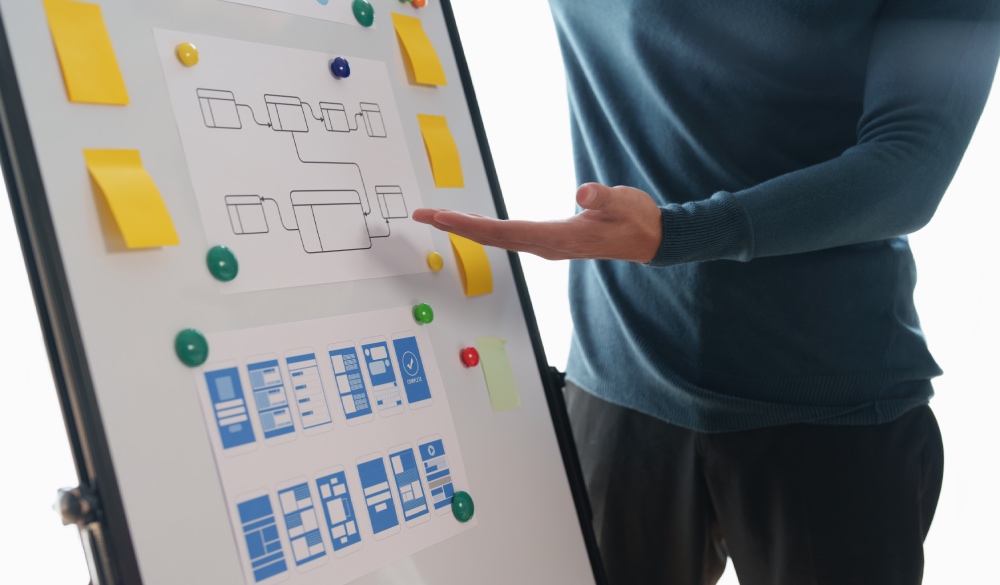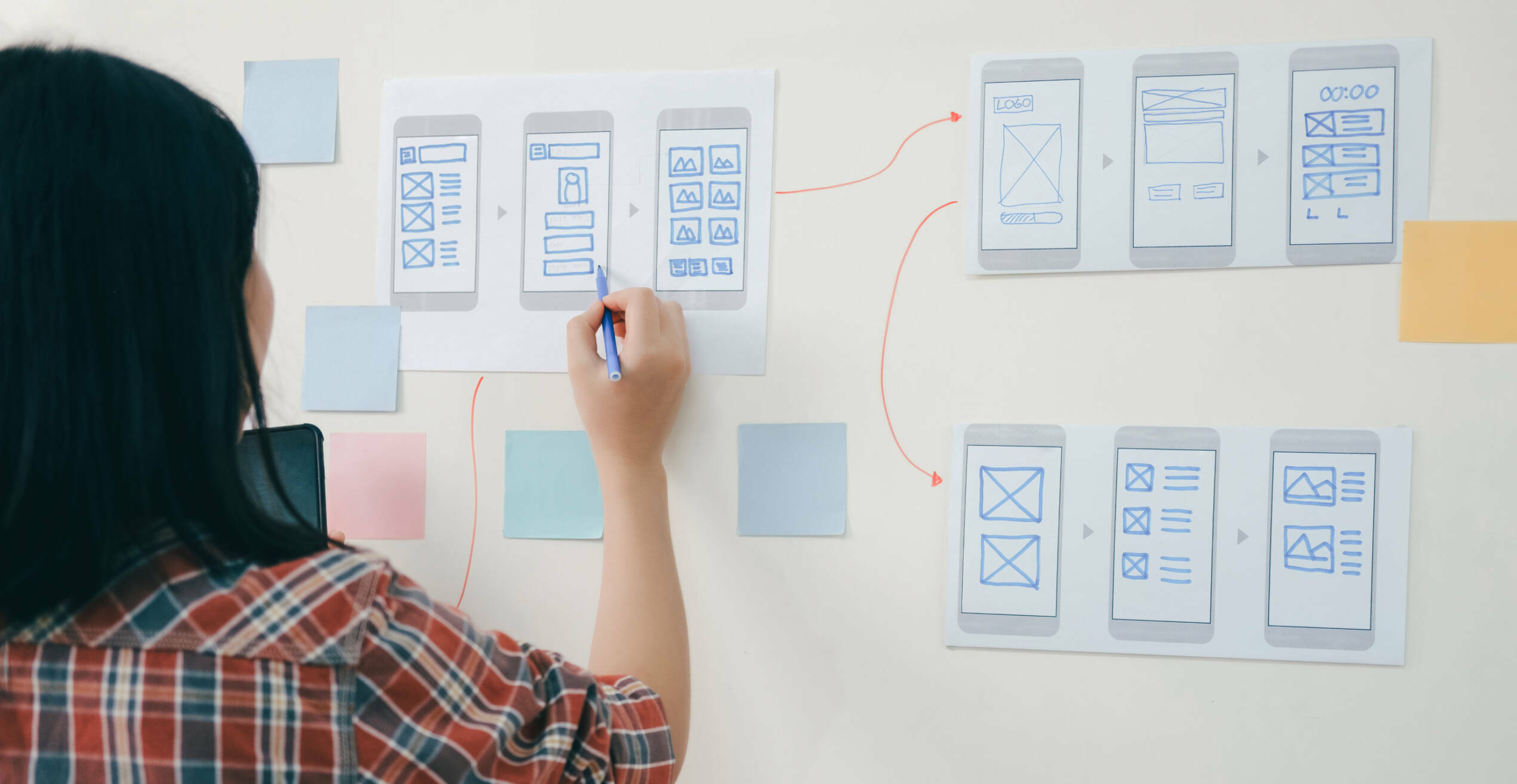The customer travels from point A to point Z when they use a company’s goods and services to fulfill their need or purpose.
This is where product and user experience designer comes into the picture and utilize a variety of tools and techniques to identify consumer needs and create products that satisfy those goals.
One such tool to employ in the early phases of the design process is the customer journey map to empathize with people and spot chances for improving the experience. A customer journey map shows the steps a user takes from the start of their journey to the point where their requirement is met.
What is a user journey?
A big spider web is a common starting point when illustrating how users would navigate around an app. It contains all of the screens and pages, with arrows leading in every direction. As a result, there is a tremendous muddle that needs more work and direction to be used by anyone else. Such a strategy only complicates matters for the user and designer as well.

A user’s journey is a linear process—the methodical steps taken by the user to accomplish a certain objective. The process is then documented in varying degrees of detail, always from the viewpoint of the user.
As a designer, you must avoid performing a technical analysis of the processes at this early level. Instead of creating a succession of pages or screens, consider what the users will do and how they will accomplish it. Later, you can choose technologically what belongs on one screen and what belongs on different pages.
Why designing flows is imperative?
We design the user flows before we begin to create screens. They could involve registering, paying for something online, or uploading images to a social media app.
These procedures decide how an app is used and the experiences it offers. Process design tools include creating user journeys or user flows. User journeys just look at what happens within the app itself, as opposed to the customer journey, which also looks at all online and offline steps before and after using the product.
The customer journey aims to gain an understanding of the setting in which consumers apply the product and to receive help with any functions that are still missing. The map’s use is described in the user journey.
In addition to developing it, we are also considering the best ways to inform consumers during the onboarding process and what flows and loops are required to entice them to return later.
How to create a user journey?
Determine the two or three most critical objectives your product should accomplish based on the concerns and motivations of your users. Consider the best path (flow) to take users to each target; the presence of numerous branches denotes a possible error.
There are several mental steps to the journey. A step is anything the users would describe as a distinct action if someone had asked what had happened to them. If we talk about a web store:
1. Go looking for the shoes.
2. Elect a favorite.
3. Make sure the size and pricing are correct.
4. Order.
Note the name of the persona and the precise objective that each travel relates to. One route, one objective. The journey’s level of complexity is entirely up to the creator. It might require a lot more detail, if necessary. On the contrary, is frequently necessary to see the processes in their entirety.
What is the user flow?
The route a user takes when utilizing a product and trying to complete a specific job is known as user flow.

The steps consumers take from the time they first access a website or application to their final action, such as making a purchase, clicking an affiliate link, or watching a video, are included in the user flow. The most crucial flows for landing pages concern the process of conversion.
Understanding user flow is crucial when designing and creating user-friendly goods and websites.
Instead of having just one user flow that incorporates all of a product’s functionality, we usually divide the UX into multiple user flows. To use it would be too difficult. Therefore, user flows typically specify specific features, some of which are only made available to users after they have been on a website for a period.
In contrast to the user journey, the user flow does not take the user’s emotions into account at any point. Instead, it focuses closely on the technical features.
What role does user flow have?
A fantastic way to categorize the user experience and specify specific actions that can be included in the design is to use user flow. It discusses what users see on screens and how they interact with them to advance.
User flow is important for the development stage because developers use it to translate designs into actual functionalities. Each stage in a user flow design is given a name, along with a brief explanation of what it does.
How does a user flow helps the design process?
You may better understand user flow by using it as a visual depiction of the functionality.
This will make it easier for you and your designers to envision exactly what a user will see at each stage of using the product. With user flows, spotting missing details, illogical procedures, or unclear content becomes incredibly simple.
What is a good user journey like?
When testing with various routes, the issue of which version performs better arises. A user flow is successful if achieving the objective is as simple and quick as possible. Take online store checkouts as an illustration.
Designers once believed that placing all the form fields on a single page would drastically speed up the checkout process, which would benefit the user. This thinking created the page with all the necessary fields on one page.
Even though all the required fields are on one page, it is ineffective. This is not to say that a successful one-page checkout is not achievable. However, just because there is only one page, in reality, does not imply that the procedure is any better.
Let’s look at a counterexample now. These websites break each step down into its page. There are numerous steps in the process, but only one choice or decision is necessary for each.
The amount of steps has no set standard. How do you dissect it? It is always based on the offered product, the users, and the needed and shown data. The cognitively most challenging situations for people are those involving decision-making, yet filling out forms can also be irksome.
Every stage of the flow should be simple, unambiguous, and simple to complete. Users won’t lose interest along the road if this is done. Additionally, integrate related actions into a single phase.
Thankfully, Tentackles provides the most imaginative user experience design services with an emphasis on increasing brand value through creative insight. Connect with us today to attract new clients and take the next step to improve your product’s user experience.


